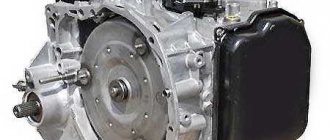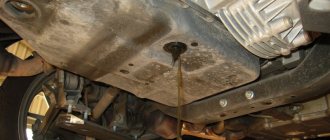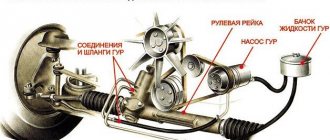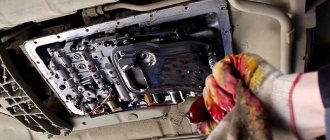Do I need to change
Replacing power steering fluid is an integral part of maintaining a vehicle equipped with hydraulic power steering.
Many automotive systems are hydraulic, meaning they operate on the principle of fluid pressure. The volume and condition of this fluid is critical for trouble-free operation of the vehicle.
Oil may leak from the power steering, it may lose its performance characteristics as a result of frequent overheating, the appearance of wear in it or other reasons. Poor condition of the fluid is manifested in difficulty turning the steering wheel, the appearance of extraneous noise and hum from the power steering pump.
Why do you need to change the power steering oil?
Power steering in a car is necessary to ease the effort of turning the steering wheel; if the power steering is faulty, the steering wheel turns hard, especially if the car is stationary. If the fluid level in the power steering pump reservoir is insufficient, turning the steering wheel is accompanied by a howling noise; the steering wheel may also be difficult to rotate in one or both directions.
Over time, the oil in the hydraulic steering system ages, loses its properties, and after a certain period of vehicle operation it must be changed. The fluid must be replaced in the following cases:
- if there is moisture in it;
- when precipitation occurs;
- when the lubricant in the hydraulic booster darkens;
- if a burning smell is detected in the oil.
Many car owners recommend changing the oil in the control unit after 50-60 thousand km of the distance traveled by the car; it is also advisable to change the fluid in case of severe contamination of the power steering reservoir.
If the car owner rarely uses the car, driving a small number of kilometers per year, in this case the power steering oil should be changed once every two or three years. Timely replacement of the power steering fluid will protect the pump and steering rack (gearbox) from damage.
How often to change
The frequency of changing the oil in the hydraulic booster is determined by the vehicle manufacturer and is indicated in the technical documentation.
If the manufacturer has not indicated the frequency, you must independently monitor the condition and change it as it becomes cloudy and darkened.
| Car manufacturer | Regulations for replacing power steering |
| Renault | 40,000 km or once every 24 months |
| Chery | 20,000 km or once every 24 months |
| Audi | 50000 km |
| Honda | 50000 km |
| Hyundai | 40000 km |
Read more about replacing power steering fluid
In fact, everything is much simpler. Any motorist who knows the principle of operation and has the necessary skills in working with tools can independently perform the procedure for replacing fluid in the power steering system. You just need to be guided by a certain simple algorithm, which will be discussed later.
Power steering fluid reservoir on the new Renault Logan (editorial car photo)
The Renault Logan uses a “classic” power steering (power steering) circuit . It includes a reservoir located in the engine compartment next to the left pillar and the battery casing. Below are the connecting pipes, a hydraulic pump driven by a belt from the engine and a spool mechanism for the steering rack.
What liquid should I use?
Power steering fluid reservoir
For normal operation of the system, 2 liters of Dexron type fluid are required. The manufacturer recommends using synthetic or semi-synthetic fluids PSF or ATF standard D2. Learn more about choosing power steering oil for Renault Logan here.
If the car is operated in difficult road conditions, where there are heavy loads on the steering mechanism and strong temperature changes, many experts recommend the use of power steering fluid of the D3 standard.
To replace power steering fluid, it is recommended to use only those recommended by the manufacturer. For example, it is better to fill the power steering with Renault PSF fluid, since it is produced specifically for use in Renault cars.
Among liquids from other manufacturers recommended for use, it should be noted:
- Castrol ATF D2 or D3,
- ELF ELFmatic G3,
- Liqui Moly ATF 1100,
- Mobil ATF 220 or 320.
The most ideal option in terms of price and quality
The use of other liquids is possible only if their viscosity parameters comply with the manufacturer's recommendations.
It is impossible to mix fluids for power steering, since when the mixed fluid operates, foaming occurs, which can lead to failure of the power steering.
Replacement Regulations
The schedule for replacing fluid in Renault Logan II is every 40,000 km or every two years, whichever comes first. But you need to check its level and condition at least once a month. The work can be combined with checking the oil level in the gearbox and checking the volume of engine oil.
Despite the regulations, you must monitor the condition of the liquid yourself. If the liquid in the tank has a pronounced dark color, there are metal particles in it, and it itself has the smell of burnt motor oil, then it needs to be changed, regardless of the replacement period according to the regulations or the mileage.
If the car has not been used for a long time, the fluid will also have to be replaced; while the car is idle, condensation could form in the power steering system, which, when mixed with the liquid, forms an emulsion. As a result, power steering fluid loses its properties.
Checking status
The check is carried out as follows: using any available tool (screwdriver, clean dipstick, pencil, stick), an oil sample is taken from the expansion tank and dripped onto a clean surface, preferably glass.
The power steering fluid should be transparent, free from impurities and foreign particles, and its original color should be easily determined.
Once you have determined that it is time to change the oil in the power steering, you need to choose the right one. The brand of liquid must be indicated in the documentation. You can find information on this page. If your car is not in the table, ask a question in the comments, we will try to find it.
Classification and features of lubricants
Based on its chemical composition, power steering fluid is divided into three main types:
- Mineral - made from natural components of petroleum products, contains additives that improve the performance of the oil. This type of oil also ensures long-term preservation of the rubber parts of the system.
- Semi-synthetic - produced from a mixture of natural and synthetic components, due to which it has a longer service life compared to mineral oils. This type of fluid improves lubricity and increases corrosion resistance.
- Synthetic - consists of monogamous alcohols, petroleum products and various additives. This oil has a high degree of serviceability, has foam-suppressing, lubricating and antioxidant properties. Synthetic oil is more aggressive and therefore has a destructive effect on rubber parts of hydraulic systems.
These types of hydraulic oils have a different color palette, namely they are divided into:
Red hydraulic fluids, also called Dexron (Dextron), are either mineral or synthetic in composition. They are used in automatic transmissions, often in cars from Japanese and Korean manufacturers.
Read also: Replacing power steering fluid Solaris
Yellow hydraulic oils come in mineral and synthetic types. This type of oil was developed by the German company Daimler and is used mainly on Mercedes cars.
Green oils are a proprietary development of the German concern Pentosin and are made using only synthetic materials. Due to this, this type of oil is used on the most modern cars of French and German brands.
Partial replacement
Partial replacement involves pumping out fluid using a syringe and tube from the power steering expansion tank. It’s difficult to call this procedure a replacement, rather a dilution, since in addition to the tank, a lot of oil is in the system itself.
If you still decide that this will be quite enough, proceed to the replacement. The cap of the expansion tank is unscrewed, and all the liquid in the tank is pumped out using a syringe with a tube attached to the end.
There may be a filter element in the neck, as is the case with the Renault Logan; it is removed after a slight rotation along the axis.
After all the old fluid has been removed, you need to fill in new fluid up to the max mark (the designations may vary on different cars; on Nissan it is cold max). Partial replacement has been made.
How to add fluid to the power steering?
Adding fluid to the power steering
Sequencing:
- unscrew the tank cap;
- use a syringe to extract the contents of the tank;
- fill the new composition to the level;
- start the engine and turn the steering wheel;
- turn off the engine and turn the steering wheel again.
Repeat the procedure until the desired result is achieved. A complete replacement will take more effort, and you will have to spend 40-60 minutes. But it will be possible to almost completely replace the old oil. The beginning is exactly the same as described in the previous method, and then the steps are as follows:
- loosen the tank clamps, remove it and wash it if necessary;
- Now you can see 2 hoses, one of them goes to the hydraulic booster pump, and the second - from the steering rack. Place the second into a previously prepared bottle;
- turn the steering wheel left and right to rid the system of old oil;
- when the contents of the tank have almost flowed out, you need to take a funnel and insert it into the second hose;
- Now take fresh oil and start pouring it into the funnel. It is good that at this moment someone actively rotates the steering wheel;
- The fluid level in the power steering reservoir will be sufficient when new, clean oil flows from the return line. Place the tank in place;
- turn the steering wheel, check the oil level and, if necessary, top up.
Complete replacement
Preparatory work includes hanging the front wheels of the car. This must be done, since the power steering system is pumped by turning the steering wheel to its extreme positions.
First of all, remove all power steering fluid from the reservoir, as in the case of a partial replacement. After this, disconnect the inlet and outlet pipes from the tank and lower them into a suitable container.
If the tank is very dirty, it is better to remove it and wash it. Any cleaner will do, you can use gasoline or kerosene, the main thing is to dry it before installation, or blow it out with a compressor.
Now, in order to expel the remnants of the old fluid from the circuit, we sit behind the wheel and turn it all the way in different directions. Many car owners start the engine for a few seconds. This activates the power steering pump and the fluid drains faster.
But manufacturers do not recommend starting the car with the fluid drained from the hydraulic fluid - this has a detrimental effect on the pump.
After the liquid stops flowing from the pipe coming from the pump, install the tank in place and fix the pipes.
Fill in new fluid to the max mark and go turn the steering wheel (no need to tighten the reservoir cap). As the oil decreases, add it. We expel the remaining air from the system with the engine running, holding the steering wheel in extreme positions for several seconds.
Check the fluid level one last time and screw on the cap. This completes the power steering oil change.
Those who want to perform a standard replacement of power steering fluid, after the described procedures, drive several tens of kilometers and change the oil again, thereby flushing the system.
How to flush the power steering?
If you detect the so-called “silver dust” - silver-colored dust that appears in the system, you need to rinse the power steering before changing the oil. This suspension quickly damages pumps, even if they have been recently installed. It is quite difficult to clean it without disassembling it, but if you do this every 10-20 thousand kilometers, this will increase the service life of the entire system. The process is carried out in several stages:
- Prepare two or more liters of new fluid suitable for your car, a container, as well as a bulb or syringe that allows you to pump out the oil from the tank;
- The easiest way is to work together, one person sits behind the wheel, and the second remains near the hood;
- Start the engine without trying to idle;
- Turn the steering wheel several times from side to side until it stops, which will allow you to mix the fluid throughout the system;
- Pump out as much fluid as possible. As a rule, this is about 200 grams. If air penetrates inside the tank, a characteristic whistle will appear and the oil will begin to foam. This process is rather beneficial, since the bubbles formed allow more debris to be removed;
- Pour in the liquid, restoring its normal volume, and start the procedure again from step 4. The sequence is repeated until all the prepared liquid is consumed;
- After flushing, fill the fluid to the nominal level, and then turn off the engine.
If the system is heavily contaminated, more than five liters of fluid may be wasted. The only alternative to this procedure is complete disassembly and cleaning. If, after replacing the power steering fluid, the steering wheel becomes stiff, the cause should be sought in the malfunction of individual components. Depending on the situation, replacing the pressure reducing valve or filter may help correct it. Sometimes such consequences result from pump failure.
With due persistence, even an inexperienced car enthusiast can replace the power steering fluid, but if there are malfunctions that cannot be dealt with, it is better to immediately contact a specialized service center.
Before purchasing this car, I certainly read the list of problem areas. One of these places is the steering system. Often, on 36s, problems arise with the power steering and steering rack. Judging by information from the previous owner, the steering rack was replaced with a new one from an E46. This information could not but make me happy, because a steering rack is an expensive pleasure, especially a new one. From my previous post you know that I encountered a problem with the steering wheel vibrating when releasing the gas. (The car runs without vibration. After we press the gas pedal and then release it, vibration is felt on the steering wheel/body of the car.) After replacing the engine mounts, the problem did not go away. And since I also replaced the box cushions, I decided to look only at the steering system. Perhaps the problem lies there?
Tips and nuances when changing oil
First of all, changing the power steering oil must be done with extreme care, otherwise there is a risk of dirt getting into the fluid, which will lead to a deterioration in its performance properties.
When pouring oil into the tank, it is necessary to rotate the steering wheel left and right so that the liquid is gradually pumped throughout the entire power steering system. After this, the oil should be brought to the desired mark on the tank and the cap should be screwed on.
Next, you need to start the engine and drive a few kilometers to check the fluid level in the tank. If it remains at the same level, then there is no need to add oil, but if it has risen to a higher level, then it is necessary to drain it. This procedure is very important, since when the tank is full, oil can splash onto the engine components, which can subsequently damage the engine.
For clarity, you can watch a video that demonstrates the entire process of changing the oil in the power steering system.
When choosing power steering oil, it is important to strictly follow the instructions. If failure to comply with the slightest rule can damage the hydraulics, then what can we say about mixing synthetics with mineral oil. High-quality oil is the key to long-term operation of the entire steering system.











